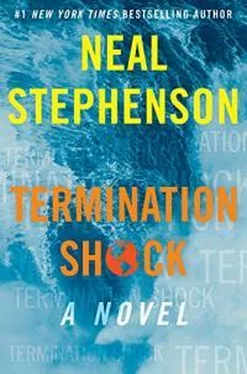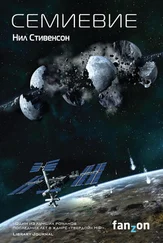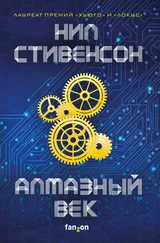Eshma happily pulled on her baseball cap, first drawing her ponytail through the little opening in the back. The Cinderella of last night had reverted to the studious and efficient nerd girl. She was just socially awkward enough that she had walked up to their table a few minutes ago and sat down without so much as a “by your leave” and a complete absence of any of that “Your Majesty” nonsense. Saskia was pleased that she’d done so and made a mental note to ask her, later, about those computational climate models that seemed to be her stock-in-trade. She had gotten the impression from Alastair that risk analysts in the financial world were basically unable to do their jobs until they got numbers from people like Eshma. They viewed the Eshmas of the world as a cross between all-knowing supergeniuses and borderline charlatans reading the future from sheep guts. In any case, the respect with which he and Mark Furlong treated Eshma was conspicuous.
Amelia’s gaze was fixed on her new baseball cap, but she wasn’t really seeing it. She was still processing Rufus’s defense-in-depth argument. “You could snip the wires and drive through anywhere—” she began.
“At three miles an hour ,” Rufus said, completing her sentence. “Might as well get out and walk. At least get you some exercise.”
“Some vehicles could go faster.”
“Tracked vehicles,” Rufus nodded. “Even they would break down. Fixing them used to be my job. But I don’t think ol’ T.R. is planning to stop an armored brigade. If it comes to that, it means his strategy failed on a whole other level.” He looked to Saskia as he said that. One of those moments, which she wished she never had to put up with, when she abruptly stopped being an ordinary participant in the conversation and was reminded that she was a queen.
The train had dropped to a deliberate speed, perhaps fifty kilometers an hour, as it felt its way across the unbelievably vast ranch—one-quarter the size of the Netherlands—on tracks that had not been built to a modern standard. If Saskia was any judge of such things, the rails themselves were in good repair—T.R. had upgraded them—but the line itself had been laid out long ago with sharp turns and steep grades. Most of the grades were uphill. Her ears popped more than once. She already knew that their destination was more than a kilometer, but less than a mile, above sea level. Not high enough that you’d really notice the thin air, but enough to buy some small advantage for the project.
They passed an airstrip. Parked there were two bizjets, three single-engine prop planes, and a helicopter. Willem had already told her that a Dutch jet would be landing there later to take them home tomorrow. So that helped her fix her location on the map. They were going southwest, directly toward the Rio Grande. The range of mountains where T.R. had built his facility was the last watershed one would cross before descending into that river’s valley and reaching the U.S./Mexico border. The Flying S Ranch ran all the way to the river’s bank.
“That off to the right, in the distance, is the Sierra Diablo,” T.R. announced, apparently referring to some craggy mountains north of them that somehow managed to look even more forbidding than T.R.’s property. “Site of the last armed conflict between Texas Rangers and Apaches in 1881.”
At the very end of the journey, the railroad track and the road became one, a strip of pavement with embedded rails, as they funneled through a short tunnel that had been blasted through a rock spur. The spur had nearly vertical sides and served as a natural barrier between the northern expanse of the Bar S, which was mostly alluvial flatland, and more broken and rugged terrain beyond that straddled the crest of the mountain range. Once they’d emerged from that tunnel—which the train passed through at no more than a brisk walking pace—they entered into a natural bowl, a few kilometers long, embraced by the primary crest of the mountains, which now loomed above them, and the smaller but more precipitous offshoot spur they’d just tunneled through. The railroad track curved round and sidled along the base of the spur before terminating. This was the end of the line. The curve enabled them all to peer forward out the windows and see that, ahead of them, the freight cars had come to a halt adjacent to various cargo handling facilities in what was apparently the main complex. This was underwhelming visually, but Saskia knew from satellite pictures that most of it was belowground. Separated from that complex by a stretch of open, uneven ground was a neat village of mobile homes, surrounded by a wall of shipping containers. It reminded Saskia of military outposts she’d visited in places such as Afghanistan.
“Welcome! We made it!” T.R. announced, and then paused for a brief round of polite applause. “You’ll notice a distinct lack of luxury accommodations. Or accommodation of any sort, really. That’s what this train is for! Not just to get y’all here, but to keep y’all comfy during your stay! For your staff, there’s plenty of space in yonder bunkhouse.” T.R. waved toward the village of mobile homes. “You are of course free to get out and walk around. Look for the individuals in the white cowboy hats! They are the good guys! And gals! You should know as much from the movies! They are here to help you and keep you safe from rattlesnakes, dehydration, hyperthermia, hypothermia, and other unique and special hazards of the Chihuahuan Desert.” Saskia looked around and noticed that several of the event staff had indeed put on white cowboy hats.
“Brown hats are ranch staff—also very helpful,” T.R. continued. “The guys and gals in the black hats are also here to keep you safe, in another sense which is perhaps hinted at by the color of their headgear. They are bad dudes and dudettes. They will not be bad to y’all , of course, but they will be bad in your service and for your protection should any issue with trespassers of the two-legged sort arise. They are, as a rule, less approachable than the white hats or the brown hats. But you may certainly approach them if you need anything. Just don’t sneak up on them. They hate that.”
The Biggest Gun in the World was so big that it had its own elevator, shoehorned into a space between two of its barrels. The elevator could only accommodate three people in comfort. So T.R. did the tour in two shifts: first Sylvester and Michiel, and, an hour later, Bob and Saskia.
Only a few buildings on the whole site rose to more than a single story aboveground. The most prominent was the head frame: a term from the mining industry referring to the aboveground machinery that bestrode a mine shaft. It was maybe ten meters high and consisted largely of open steel framing through which large reels of cable, motors, and other lifting-and-hoisting sorts of gear were visible. Pipes and cables converged on it from other parts of the complex and plunged down into the shaft.
Of course you couldn’t dig a shaft without raking up the rock and dirt you were displacing. This material—“spoil”—had been distributed around the complex and used to buttress, or to completely bury, outlying facilities such as tanks, processing plants, and buildings that seemed to have a lot of expensive people in them (“command and control” in T.R.-speak). Without being terribly obvious about it, the designers had, in other words, hardened the site. Rufus, at a glance, had identified some of the spoil-piles as “revetments,” obliging Saskia to look up the word. It meant a sort of blast wall built around a potential target to protect from near misses by artillery. It didn’t take a military expert to know that a cruise missile could obliterate anything on the surface. But it seemed proof against small, furtive attacks such as bomb-bearing drones or mountaintop snipers. Large areas were screened by nets with strips of fabric woven through them. Their purpose wasn’t entirely clear to her, but they would definitely stop drones, provide much needed shade, and make things complicated for surveillance satellites.
Читать дальше

![Нил Стивенсон - Криптономикон [litres]](/books/23868/nil-stivenson-kriptonomikon-litres-thumb.webp)







![Нил Стивенсон - Лавина [litres с оптимизированной обложкой]](/books/414066/nil-stivenson-lavina-litres-s-optimizirovannoj-ob-thumb.webp)
